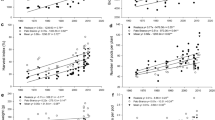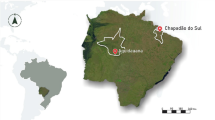Abstract
Currently, there is demand for high yield soybean cultivars associated with seeds of high physiological quality. The launch of high yield soybean cultivars associated with high quality seeds in soybean is big challenge due to the lack of a straight correlation between agronomic traits and seed quality. The genetic and phenotypic parameters associated with the physiological quality of seeds could help the soybean breeders to development the strategies to achieve this goal. This research aims to estimate the genetic and phenotypic parameters associated with traits related to the physiological quality of seeds soybean progenies, as well as to quantify the effect of selection for grain yield on the physiological quality of seeds. A total of 131 progenies were evaluated from the 2015/2016, and from these, 51 progenies were evaluated at the 2016/2017 season. Physiological quality was evaluated under controlled conditions using germination tests, seedling length tests, tetrazolium tests and emergence tests. Heritability, expected genetic gains, variance components and correlated response were estimated. The variance components due to variation in the progenies were significant for most traits, showing variability. The interaction of progeny by environment was significant, suggesting that environmental factors influence seed production and quality. The magnitudes of heritability and expected selection gain suggested that physiological quality can be successfully improved. Estimates of the correlation responses showed that selection for grain yield is also reflected in gains in the seed quality.
Similar content being viewed by others
References
Amaral LO, Bruzi AT, Resende PM, Silva KB (2019) Pure line selection in a heterogeneous soybean cultivar. Crop Breed Appl Biotechnol 19:277–284. https://doi.org/10.1590/1984-70332019v19n3a39
Aosa I (1983) Seed vigor testing handbook. Association of Official Seed Analysts. Contribution, 32, pp 88
Bernardo R (2002) Breeding for quantitative traits in plants. Stemma Press, Woodbury
Brasil Ministério da Agricultura, Pecuária e Abastecimento. Secretaria de Defesa Agropecuária (2009) Regras para análise de sementes Brasília, DF: ed Mapa/ACS, pp 399
Carbonell SAM, Vello NA (2001) Genetic analysis of soybean seed response to mechanical damage. Crop Breed Appl Biotechnol 1:35–43
Climate-Data.Org (2017) https://pt.climate-data.org/location/176032/. Accessed 29 December 2017
Farias JRB, Nepomuceno AL, Neumaier N (2007) Ecofisiologia da soja, 48rd EMBRAPA Soja, Londrina, pp 9
Fehr WR, Caviness CE (1977) Stages of soybean development. Ames: Iowa States University of Science and Technology pp 11 (Special Report, 80)
França-Neto JB, Krzyzanovski FC, Costa NP (1998) O teste de tetrazólio em sementes de soja. In: EMBRAPA- CNPSo (ed) Documento 116, Londrina, pp 72
Gesteira GS, Bruzi AT, Zito RK, Fronza V, Arantes NE (2018) Selection of early soybean inbred lines using multiple index. Crop Sci 58:2494–2502. https://doi.org/10.2135/cropsci2018.05.0295
Gezan SA, Munoz PR (2014) Analysis of experiments using ASReml with emphasis on breeding trials. Retrieved May 15, 2019
Inmet (2018) Banco de Dados Meteorológicos para Ensino e Pesquisa. Instituto Nacional de Meteorologia http://www.inmet.gov.br/portal/index.php?r=bdmep/bdmep. Acessed 07 January 2018
Keep NR, Schapaugh WT Jr, Prasad PVV, Boyer JE Jr (2016) Changes in physiological traits in soybean with breeding advancements. Crop Sci 56:122–131. https://doi.org/10.2135/cropsci2013.07.0499
Maguire JD (1962) Speed of germination-aid in relation evaluation for seedling emergence vigor. Crop Sci 2:176–177
Martins CC, Unêda-Trevisoli SH, Môro GV, Vieira RD (2016) Methodology for the selection of soybean strains for germination, vigour and field emergence. Rev Ciênc Agron 47(3):455–461
Menezes MD, Von Pinho ÉVDR, José SCBR, Baldoni A, Mendes FF (2009) Chemical and structural aspects of the physiological quality of soybean seeds. Pesq Agrop Brasileira 44(12):1716–1723. https://doi.org/10.1590/S0100-204X2009001200022
Nakagawa J (1999) Testes de vigor baseados no desempenho das plântulas. In: Krzyzanowski FC, Vieira RD, França Neto JB (ed) Vigor de sementes: conceitos e testes, 2rd edn. Londrina, Paraná pp 2–1
Piepho HP, Mohring J, Melchinger AE (2008) BLUP for phenotypic selection in plant breeding and variety testing. Euphytica 161:209–228
R Core Team (2018) R: a language and environment for statistical computing. R Foundation for Statistical Computing, Vienna, Austria
Silva KB, Bruzi AT, Zuffo AM, Zambiazzi EV, Soares IO, Rezende PM, Coelho MDO (2015) Adaptability and phenotypic stability of soybean cultivars for grain yield and oil content. Genet Mol Res 15:2. https://doi.org/10.4238/gmr16029646
Soares IO, Rezende PM, Bruzi AT, Zuffo AM, Zambiazzi EV, Fronza V, Teixeira CM (2015) Interaction between soybean cultivars and seed density. Am J Plant Sci 6:1425–1434. https://doi.org/10.4236/ajps.2015.69142
Soares IO, Bianchi MC, Bruzi AT, Gesteira GDS, Silva KB, Guilherme SR, Cianzio SR (2020) Genetic and phenotypic parameters associated with soybean progenies in a recurrent selection program. Crop Breed Appl Biotechnol. https://doi.org/10.1590/1984-70332020v20n4a59
Todeschini MH, Milioli AS, Rosa AC, Dallacorte LV, Panho MC, Marchese JA, Benin G (2019) Soybean genetic progress in South Brazil: physiological, phenological and agronomic traits. Euphytica 215:124. https://doi.org/10.1007/s10681-019-2439-9
USDA (2019) World Agricultural Production. Circ. Ser. WAP 6–19. USDA Foreign Agric. Serv., Washington, DC. https://apps.fas.usda.gov/psdonline/circulars/production.pdf. Accessed 8 July 2019
van Eeuwijk FA, Bustos-Korts DV, Malosetti M (2016) What should students in plant breeding know about the statistical aspects of genotype × environment interactions? Crop Sci 56:2119–2140. https://doi.org/10.2135/cropsci2015.06.0375
Zambiazzi EV, Bruzi AT, Guilherme SR, Pereira DR, Lima JG, Zuffo AM, Ribeiro FO, Mendes AES, Godinho SHM, Carvalho MLM (2017) Estimates of genetics and phenotypics parameters for the yield and quality of soybean seeds. Genet Mol Res 16:3. https://doi.org/10.4238/gmr16039801
Acknowledgements
This work it was financed in part by the Coordenação de Aperfeiçoamento de Pessoal de Nível Superior—Brasil (CAPES)—Finnacial Code 001. This work was supported by the Conselho Nacional de Desenvolvimento Científico e Tecnológico – CNPq / MCTIC, through grant of productivity to the author Adriano Teodoro Bruzi.
Author information
Authors and Affiliations
Corresponding author
Additional information
Publisher's Note
Springer Nature remains neutral with regard to jurisdictional claims in published maps and institutional affiliations.
Rights and permissions
About this article
Cite this article
Monteiro, F.F., Bruzi, A.T., Silva, K.B. et al. Breeding for yield and seed quality in soybean. Euphytica 217, 212 (2021). https://doi.org/10.1007/s10681-021-02943-4
Received:
Accepted:
Published:
DOI: https://doi.org/10.1007/s10681-021-02943-4






